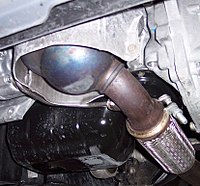
Photo from wikipedia
Understanding the manufacture and operation of automotive emissions control particulate filters is important in the optimised design of these emissions control systems. Here we show how magnetic resonance imaging (MRI)… Click to show full abstract
Understanding the manufacture and operation of automotive emissions control particulate filters is important in the optimised design of these emissions control systems. Here we show how magnetic resonance imaging (MRI) can be used to understand the drying process, which is part of the manufacture of catalysed particulate filters. Comparison between a wall-flow particulate filter substrate and a flow-through monolith (FTM) has been performed, with MRI giving spatial information on the drying process. We have also used MRI to study the fluid dynamics of a gasoline particulate filter (GPF). Inlet and outlet channel gas velocities have been measured for a clean GPF and two GPF samples loaded with particulate matter (PM) to understand the effect of PM on the filter flow profiles and porous wall permeability as soot is deposited.
Journal Title: Johnson Matthey Technology Review
Year Published: 2020
Link to full text (if available)
Share on Social Media: Sign Up to like & get
recommendations!